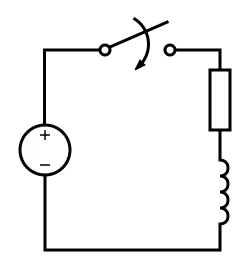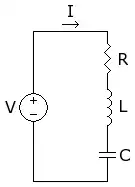Series Circuit
Electronic components R,L,C can be connected in parallel to form RL, RC, LC, RLC series circuit
- RC Parallel
- RL Parallel
- LC Parallel
- RLC Parallel
Parallel RC

The total Impedance of the circuit

 )
)- T = RC
At Equilibrium sum of all voltages equal zero




- ln V =




- T = RC
Circuit's Impedance in Polar coordinate



Phase Angle Difference Between Voltage and Current
There is a difference in angle Between Voltage and Current . Current leads Voltage by an angle θ

Summary
RL series circuit has a first order differential equation of voltage

Which has one real root


The Natural Response of the circuit at equilibrium is a Exponential Decrease function
Phase Angle Difference Between Voltage and Current

Parallel RL

The total Circuit's Impedance In Rectangular Coordinate



At Equilibrium sum of all voltages equal zero



- ln I =

- I =

- I =

- I =

Circuit's Impedance In Polar Coordinate


Phase Angle of Difference Between Voltage and Current

Summary
In summary RL series circuit has a first order differential equation of current

Which has one real root


The Natural Response of the circuit at equilibrium is a Exponential Decrease function
Phase Angle of Difference Between Voltage and Current

Parallel LC
Natural Response
The Total Circuit's Impedance in Rectangular Form

 . ZL = ZC
. ZL = ZC . ZL = ZC
. ZL = ZC
Circuit's Natural Response at equilibrium







The Natural Response at equilibrium of the circuit is a Sinusoidal Wave
Resonance Response
At Resonance, The total Circuit's impedance is zero and the total volages are zero





The Resonance Reponse of the circuit at resonance is a Standing (Sinusoidal) Wave
Parallel RLC
Natural Response

At Equilibrium, the sum of all voltages equal to zero





Với
 và
và

Khi 


- The response of the circuit is an Exponential Deacy
Khi 


- The response of the circuit is an Exponential Deacy
Khi 


- The response of the circuit is an Exponential decay sinusoidal wave
Điện Kháng Tổng Mạch Điện



Resonance Response
The total impedance of the circuit





At resonance frequency  the total impedance of the circuit is Z = R ; at its minimum value and current will be at its maximum value :
the total impedance of the circuit is Z = R ; at its minimum value and current will be at its maximum value : 
Look at the circuit, at  , Capacitor opens circuit . Therefore, current is equal to zero . At
, Capacitor opens circuit . Therefore, current is equal to zero . At  , Inductor opens circuit . Therefore, current is equal to zero
, Inductor opens circuit . Therefore, current is equal to zero
Summary
Series RL, RC
Series RC and RL has a Character first order differential equation of the form

that has Decay exponential function as Natural Response

- f(t) = i(t) for series RL
- f(t) = v(t) for series RC
Series LC, RLC
Series LC and RLC has a Characteristic Second order differential equation of the form



At equilibrium , the Natural Response of the circuit is Sinusoidal Wave

At Equilibrum , the Resonance Response is Standing Wave Reponse


